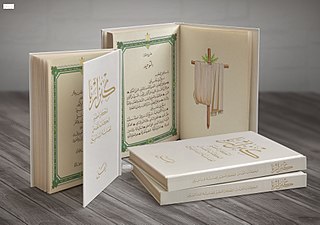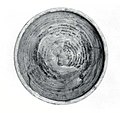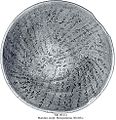
Lilith, also spelt Lilit, Lilitu, or Lilis, is a female figure in Mesopotamian and Jewish mythology, theorized to be the first wife of Adam and a primordial she-demon. Lilith is cited as having been "banished" from the Garden of Eden for not complying with and obeying Adam.

Magic is an ancient practice rooted in rituals, spiritual divinations, and/or cultural lineage—with an intention to invoke, manipulate, or otherwise manifest supernatural forces, beings, or entities in the natural world. It is a categorical yet often ambiguous term which has been used to refer to a wide variety of beliefs and practices, frequently considered separate from both religion and science.

Mandaeans, also known as Mandaean Sabians or simply as Sabians, are an ethnoreligious group who are followers of Mandaeism. They believe that John the Baptist was the final and most important prophet. They may have been among the earliest religious groups to practice baptism, as well as among the earliest adherents of Gnosticism, a belief system of which they are the last surviving representatives today. The Mandaeans were originally native speakers of Mandaic, an Eastern Aramaic language, before they nearly all switched to Mesopotamian Arabic or Persian as their main language.

Mandaic, or more specifically Classical Mandaic, is the liturgical language of Mandaeism and a South Eastern Aramaic variety in use by the Mandaean community, traditionally based in southern parts of Iraq and southwest Iran, for their religious books. Mandaic, or Classical Mandaic is still used by Mandaean priests in liturgical rites. The modern descendant of Mandaic or Classical Mandaic, known as Neo-Mandaic or Modern Mandaic, is spoken by a small group of Mandaeans around Ahvaz and Khorramshahr in the southern Iranian Khuzestan province.
In Jewish mythology, mazzikin are invisible demons that can create minor annoyances or greater dangers. This Aramaic term, which is found in the Talmud, means "damagers" or "those who harm". It is generally understood to mean harmful invisible demons that a person could encounter in daily life. While Judaism today does not often directly discuss evil spirits, as late as the Geonic period, incantation bowls made by Aramaic-speaking inhabitants of Mesopotamia and the Levant were a method of protecting individuals from a large array of demons and similar spirits, such as disease spirits, mazzikin, lilin, and shedim.
The Mandaic alphabet is a writing system primarily used to write the Mandaic language. It is thought to have evolved between the second and seventh century CE from either a cursive form of Aramaic or from Inscriptional Parthian. The exact roots of the script are difficult to determine. It was developed by members of the Mandaean faith of Lower Mesopotamia to write the Mandaic language for liturgical purposes. Classical Mandaic and its descendant Neo-Mandaic are still in limited use. The script has changed very little over centuries of use.

Mandaeism, sometimes also known as Nasoraeanism or Sabianism, is a Gnostic, monotheistic and ethnic religion with Greek, Iranian, and Jewish influences. Its adherents, the Mandaeans, revere Adam, Abel, Seth, Enos, Noah, Shem, Aram, and especially John the Baptist. Mandaeans consider Adam, Seth, Noah, Shem and John the Baptist prophets, with Adam being the founder of the religion and John being the greatest and final prophet.

Asoristan was the name of the Sasanian province of Assyria and Babylonia from 226 to 637.

An amulet, also known as a good luck charm or phylactery, is an object believed to confer protection upon its possessor. The word "amulet" comes from the Latin word amuletum, which Pliny's Natural History describes as "an object that protects a person from trouble". Anything can function as an amulet; items commonly so used include statues, coins, drawings, plant parts, animal parts, and written words.
In the myth and folklore of the Near East and Europe, Abyzou is the name of a female demon. Abyzou was blamed for miscarriages and infant mortality and was said to be motivated by envy, as she herself was infertile. In the Coptic Egypt she is identified with Alabasandria, and in Byzantine culture with Gylou, but in various texts surviving from the syncretic magical practice of antiquity and the Early Middle Ages, she is said to have many or virtually innumerable names.
A lilu or lilû is a masculine Akkadian word for a spirit or demon.
Jewish magical papyri are a subclass of papyri with specific Jewish magical uses, and which shed light on popular belief during the late Second Temple Period and after in Late Antiquity. A related category of contemporary evidence are Jewish magical inscriptions, typically on amulets, ostraca, and incantation bowls.
Bagdana is a demon in Jewish magical texts from early medieval Mesopotamia. The name is found on incantation bowls, and Aramaic incantation texts from Nippur.
4Q510–511, also given the title Songs of the Sage or Songs of the Maskil, is a fragmentary Hebrew-language manuscript of a Jewish magical text of incantation and exorcism in the Dead Sea Scrolls, specifically for protection against a list of demons. It is notable for containing the first clear usage of the Hebrew term lilith in relation to a supernatural creature. It is comparable to Aramaic incantation 4Q560 and also 11Q11.
Mullissu is a goddess who is the consort of the Assyrian god Asshur. Mullissu may be identical with the Sumerian goddess Ninlil, wife of the god Enlil, which would parallel the fact that Asshur himself was modeled on Enlil. Mullissu's name was written dnin.líl. Mullissu is identified with Ishtar of Nineveh in the Neo-Assyrian Empire times.
Zisurrû, meaning “magic circle drawn with flour,” and inscribed ZÌ-SUR-RA-a, was an ancient Mesopotamian means of delineating, purifying and protecting from evil by the enclosing of a ritual space in a circle of flour. It involved ritual drawings with a variety of powdered cereals to counter different threats and is accompanied by the gloss: SAG.BA SAG.BA, Akkadian: māmīt māmīt, the curse from a broken oath, in The Exorcists Manual, where it refers to a specific ritual on two tablets the first of which is extant.
The historiola is a modern term for a kind of incantation incorporating a short mythic story that provides the paradigm for the desired magical action. It can be found in ancient Mesopotamian, Egyptian and Greek mythology, in the Aramaic Uruk incantation, incorporated in Mandaean incantations, as well as in Jewish kabbalah. There are also Christian examples evoking Christian legends.
Mandaic lead rolls, sometimes also known as Mandaic amulets or sheets, which are related to Palestinian and Syrian metal amulets, are a specific term for a writing medium containing incantations in the Mandaic script incised onto lead sheets with a pin. Some Mandaic incantations are found on gold and silver sheets. They are rolled up and then inserted into a metal capsule with loops on it to be worn around the neck on a string or necklace.
The Aramaic Uruk incantation acquired 1913 by the Louvre, Paris and stored there under AO 6489 is a unique Aramaic text written in Late Babylonian cuneiform syllable signs and dates to the Seleucid Empire ca. 150 BCE. The finding site is the reš-sanctuary in the ancient city of Uruk (Warka), therefore the label “Uruk”. Particular about this incantation text is that it contains a magical historiola which is divided up into two nearly repetitive successive parts, a text genre that finds its continuation in the Aramaic magical text corpus of late antiquity from Iraq and Iran, most prominently in incantation bowls and Mandaic lead rolls.

Matthew Morgenstern, also known as Moshe Morgenstern, is an Israeli linguist and religious studies scholar known for his work on Eastern Aramaic languages, especially Mandaic. He is currently Full Professor in the Department of Hebrew Language and Semitic Linguistics at Tel Aviv University.















